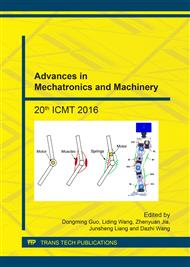[1]
Zhao Chenchen, Xie Cuifang, Zhu Xuejun, Research on CO2 concentration reality influence model of fruiting body growth period of pleurotus eryngii, Journal of Chinese Agricultural Mechanization. 7(2015)83-87+99.
Google Scholar
[2]
Li Zhao, Xuejun Zhu, The development of remote monitoring system for cultivation environment of Pleurotus eryngii, Proceeding of the 2015 IEEE International Conference on Information and Automation, August 8-10, Lijiang: Institute of Electrical and Electronics Engineers Inc. 1(2015).
DOI: 10.1109/icinfa.2015.7279731
Google Scholar
[3]
Xiaoqing Tian, Li Zhao, Huige Lai, Xuejun Zhu: submitted to Proceeding of the 2016 IEEE International Conference on Information and Automation (2016).
Google Scholar
[4]
Tong Ying, Zhong wei, Tong Shuiguang, Performance Online Prediction of Supercritical Boilers Based on Mechanism and Data-driven Model, Proceedings of the CSEE. 35(2015)2487-2494.
Google Scholar
[5]
Ramon Huerta, Thiago Mosqueiro, Jordi Fonollosa, Nikolai F Rulkov, Irene Rodriguez-Lujan, Online decorrelation of humidity and temperature in chemical sensors for continuous monitoring, Chemometrics and Intelligent Laboratory Systems. 157 (2016).
DOI: 10.1016/j.chemolab.2016.07.004
Google Scholar
[6]
Magdi S. Mahmoud, Naif B. Almutairi, Feedback fuzzy control for quantized networked systems with random delays, Applied Mathematics and Computation. 290(2016)80–97.
DOI: 10.1016/j.amc.2016.05.040
Google Scholar
[7]
Xiaoqing Tian, Xuejun Zhu, Research on Loop Control Strategies of CO2 concentration based on BPNN for Pleurotus Eryngii in a factory farm, Edible Fungi of China. 35(2016)46-49+53.
Google Scholar
[8]
Li Zhao, Xuejun Zhu, Xueping Bai, et al, Build model for humidity of the Pleurotus and controller design and Simulation, Journal of Chinese Agricultural Mechanization. 37(2016)79-83.
Google Scholar
[9]
Feng Guo, Lin Lin, Chen Wang, Novel continuous function prediction model using an improved Takagi–Sugeno fuzzy rule and its application based on chaotic time series, Engineering Applications of Artificial Intelligence. 55 (2016) 155–164.
DOI: 10.1016/j.engappai.2016.06.013
Google Scholar
[10]
Kewen Li, Lu Liu, Jiannan Zhai, Taghi M. Khoshgoftaar, Timing Li, The improved grey model based on particle swarm optimization algorithm for time series prediction, Engineering Applications of Artificial Intelligence. 55 (2016) 285–291.
DOI: 10.1016/j.engappai.2016.07.005
Google Scholar
[11]
Bo Liu, Jie Hu, Fuwu Yan, Richard Fiifi Turkson, Feng Lin, A novel optimal support vector machine ensemble model for NOX emissions prediction of a diesel engine, Measurement. 92 (2016) 183–192.
DOI: 10.1016/j.measurement.2016.06.015
Google Scholar


